Marcia Thornton Jones's Blog, page 153
April 16, 2016
Step Into Your Character's Shoes: April Theme by Naomi Kinsman
We think differently in motion than we do when we're sitting in our chairs, staring at our computer screens. This video is a 9-ish minute exercise that will take you through a movement sequence to explore three characters. To complete this exercise, all you'll need is a room with a little room for movement. Don't worry too much about being able to see me on video while you move. I'm just talking to the camera to give you the instructions you need.
Who might this brainstorming exercise help? Anyone who:
Needs a warm-up before a writing sessionIs ready to start a new story but hasn't settled on a character yetIs in the messy middle of writing a story and needs a little creativity boost ... and possibly a new character to add into the mixThis exercise is the perfect physical and mental warm-up to filling out a character questionnaire. If you don't have one you love to use and would like one of mine, reach out and let me know over at naomikinsman.com.
Here's to you and your creativity!
~~~~~~~~~~~~
Naomi Kinsman is an author, educator and creativity coach. She is the author of the FROM SADIE'S SKETCHBOOK series and recently collaborated with singer, Natalie Grant on the GLIMMER GIRLS series. Naomi is also the founder and Executive Director or Society of Young Inklings, which offers classes, mentorships and publishing opportunities for young authors ages 6-16. Society of Young Inklings utilizes WRITERLY PLAY, the improv-based teaching methodology that Naomi developed, as the foundation for all of its programming. www.naomikinsman.com
Published on April 16, 2016 11:36
April 14, 2016
Brainstorm Crew by Bob Krech
I'm okay brainstorming on my own, but I prefer brainstorming with at least one other person, usually my wife or one of my kids. Sometimes I grab friends if they know something about the content or setting of what I'm working on. They always think of or remember things that I wouldn't have. I am often surprised at how we tend to pay attention to different kinds of details.
When I wrote Love Puppies and Corner Kicks, a story about a girl soccer player moving from New Jersey to Scotland, I brainstormed with my wife by just asking her what she remembered about Scotland from our three years of teaching there. I hit up my daughter about her soccer playing days too. I picked up a lot of material that made it's way into the book. It was productive and fun too!
I'm always bouncing things of off them and reading aloud passages to get their reactions. My brainstorming crew don't seem to mind these sessions, maybe because when the book comes out, they know there's some of themselves in there. It's all good, as long as they don't ask for a cut of the royalties. :)
When I wrote Love Puppies and Corner Kicks, a story about a girl soccer player moving from New Jersey to Scotland, I brainstormed with my wife by just asking her what she remembered about Scotland from our three years of teaching there. I hit up my daughter about her soccer playing days too. I picked up a lot of material that made it's way into the book. It was productive and fun too!
I'm always bouncing things of off them and reading aloud passages to get their reactions. My brainstorming crew don't seem to mind these sessions, maybe because when the book comes out, they know there's some of themselves in there. It's all good, as long as they don't ask for a cut of the royalties. :)
Published on April 14, 2016 23:30
Sifting Through the Colorful Mess of a Brainstorm – April Theme from Tamera Wissinger
When I brainstorm on paper it's messy. Here is a small example of what mine can look like:
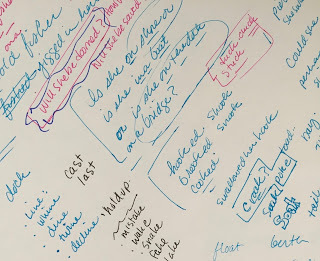
This was a brainstorm for a picture book that I was working on a while back. By the time I come to this stage, I know the basic concept that I’m after, but I need to figure out how to make it come together. For me that includes doodling, using colorful pens, making a mess on paper to get all of the ideas out of my brain, and generating new ideas and connections that I hadn’t been considering. Then it’s a process of sifting through the mess to find something cohesive that will stick together. Something that might someday become a book. That’s what happened with this brainstorm. After a long wait and many versions, those messy brainstorm notes became a picture book that released earlier this year called THERE WAS AN OLD LADY WHO GOBBLED A SKINK. It’s from Sky Pony Press and illustrated by Ana Bermejo.
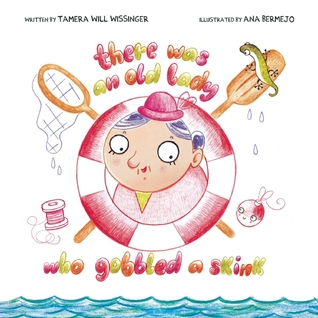 From brainstorm to book!I know this isn’t the right process for everyone, but it’s the one that works for me whether I’m brainstorming a picture book, a single poem, or a middle grade novel. How do you brainstorm?
From brainstorm to book!I know this isn’t the right process for everyone, but it’s the one that works for me whether I’m brainstorming a picture book, a single poem, or a middle grade novel. How do you brainstorm?
~~~~~
Tamera Wissinger writes stories and poetry for children including Gone Fishing: A Novel in Verse from HMH Children’s, This Old Band, and There Was An Old Lady Who Gobbled a Skink from Sky Pony Press. Her second middle grade story, Gone Camping: A Novel in Verse (HMH), is also a product of the colorful messy brainstorm process and arrives in 2017. You can connect with Tamera online at her website, on Twitter, or on Facebook.

This was a brainstorm for a picture book that I was working on a while back. By the time I come to this stage, I know the basic concept that I’m after, but I need to figure out how to make it come together. For me that includes doodling, using colorful pens, making a mess on paper to get all of the ideas out of my brain, and generating new ideas and connections that I hadn’t been considering. Then it’s a process of sifting through the mess to find something cohesive that will stick together. Something that might someday become a book. That’s what happened with this brainstorm. After a long wait and many versions, those messy brainstorm notes became a picture book that released earlier this year called THERE WAS AN OLD LADY WHO GOBBLED A SKINK. It’s from Sky Pony Press and illustrated by Ana Bermejo.
 From brainstorm to book!I know this isn’t the right process for everyone, but it’s the one that works for me whether I’m brainstorming a picture book, a single poem, or a middle grade novel. How do you brainstorm?
From brainstorm to book!I know this isn’t the right process for everyone, but it’s the one that works for me whether I’m brainstorming a picture book, a single poem, or a middle grade novel. How do you brainstorm?~~~~~
Tamera Wissinger writes stories and poetry for children including Gone Fishing: A Novel in Verse from HMH Children’s, This Old Band, and There Was An Old Lady Who Gobbled a Skink from Sky Pony Press. Her second middle grade story, Gone Camping: A Novel in Verse (HMH), is also a product of the colorful messy brainstorm process and arrives in 2017. You can connect with Tamera online at her website, on Twitter, or on Facebook.
Published on April 14, 2016 16:56
April 12, 2016
The Brainstorm Behind WOMEN WHO CHANGED THE WORLD
Laurie Calkhoven (from our own Smack Dab group) has always been one of my favorite writers of historical fiction. When I heard about her new book, WOMEN WHO CHANGED THE WORLD, I had to ask her about it. Talk about a brainstorm! Here's Laurie:
WOMEN WHO CHANGED THE WORLD grew out of my desire for a woman president! I had written a book called I GREW UP TO BE PRESIDENT. On my school visits, kids loved hearing about the presidents’ childhoods. I made a point of telling them that presidents had all started out as ordinary boys who grew up to be extraordinary, and that they had the same opportunity. Every time I talked about the book, I mentioned that it was one day going to include a girl.
I got tired of waiting. Why not write a book about ordinary girls who grew up to be extraordinary? I put together a proposal and sent it to my editor at Scholastic, and happily she and her colleagues liked the idea as much as I did. Beginning with Pocahontas and taking us all the way through Misty Copeland, WOMEN WHO CHANGED THE WORLD is about 50 influential and inspiring American girls who grew up to change the world.
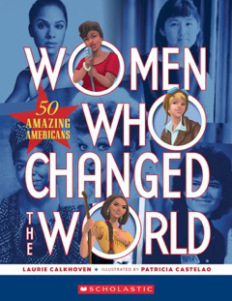 The research was both interesting and a challenge, especially for women like Pocahontas and Sacagawea. What’s real and what’s myth? Sometimes it’s hard to tell. Even modern women can be a challenge. Every biography, encyclopedia entry, and magazine article I read about Julia Child listed a slightly different height!
The research was both interesting and a challenge, especially for women like Pocahontas and Sacagawea. What’s real and what’s myth? Sometimes it’s hard to tell. Even modern women can be a challenge. Every biography, encyclopedia entry, and magazine article I read about Julia Child listed a slightly different height!
Thank goodness for the New York Public Library and its extensive databases. I couldn’t tell you how many books, magazine and newspaper articles, and database entries I read in total. There were at least 10 and sometimes 20-30 for each woman. But along the way I learned wonderful, sometimes maddening, and always inspiring things.
Nellie Bly, for instance, got her start as a journalist after reading a newspaper article that called working women a “monstrosity.” She wrote an angry letter to the editor, who promptly hired her.
Babe Didrikson Zaharias, the greatest female athlete of the twentieth century, earned her nickname because she hit five homeruns in one neighborhood baseball game—just like Babe Ruth.
Patsy Mink, the first congresswoman of color and the driving force behind Title Nine, became a lawyer because she couldn’t find a medical school that would admit a woman. Then she discovered that law firms wouldn’t hire her for the same reason. So, she started her own.
The first woman to reach both the North and South Poles, Ann Bancroft, said her dyslexia was the perfect training for joining a polar expedition. On an expedition you have to focus on putting one foot in front of the other—just like you have to do every single day with a learning disability.
Nobel-prize winning geneticist Barbara McClintock’s favorite microscope is on view at the Smithsonian. Don’t you just love that she had a favorite microscope?
I could go on and on. Harriet Tubman was forced to turn back on her first attempt to escape slavery. At 15, Lucille Ball traveled to New York City to study acting. Her teacher sent her back home with the news that she didn’t have any talent. Julia Child was a disaster in her first cooking class.
Those stories especially, about women who looked failure in the face and kept going, are my favorites. Those are the stories I most want kids to read. I want them to know that when someone tries to diminish them or their dreams, they can go on—and succeed.
 Laurie Calkhoven spent 20 years working in book publishing helping other people bring their books into the world and planning to be a writer “one day.” Finally, with 40 looming, she realized she had to make one day happen. Since then she’s written a broad range of fiction and nonfiction for young readers including six novels for American Girl and a series of historical action/adventure novels called Boys of Wartime. She lives in New York City.
Laurie Calkhoven spent 20 years working in book publishing helping other people bring their books into the world and planning to be a writer “one day.” Finally, with 40 looming, she realized she had to make one day happen. Since then she’s written a broad range of fiction and nonfiction for young readers including six novels for American Girl and a series of historical action/adventure novels called Boys of Wartime. She lives in New York City.
WOMEN WHO CHANGED THE WORLD grew out of my desire for a woman president! I had written a book called I GREW UP TO BE PRESIDENT. On my school visits, kids loved hearing about the presidents’ childhoods. I made a point of telling them that presidents had all started out as ordinary boys who grew up to be extraordinary, and that they had the same opportunity. Every time I talked about the book, I mentioned that it was one day going to include a girl.
I got tired of waiting. Why not write a book about ordinary girls who grew up to be extraordinary? I put together a proposal and sent it to my editor at Scholastic, and happily she and her colleagues liked the idea as much as I did. Beginning with Pocahontas and taking us all the way through Misty Copeland, WOMEN WHO CHANGED THE WORLD is about 50 influential and inspiring American girls who grew up to change the world.
 The research was both interesting and a challenge, especially for women like Pocahontas and Sacagawea. What’s real and what’s myth? Sometimes it’s hard to tell. Even modern women can be a challenge. Every biography, encyclopedia entry, and magazine article I read about Julia Child listed a slightly different height!
The research was both interesting and a challenge, especially for women like Pocahontas and Sacagawea. What’s real and what’s myth? Sometimes it’s hard to tell. Even modern women can be a challenge. Every biography, encyclopedia entry, and magazine article I read about Julia Child listed a slightly different height!Thank goodness for the New York Public Library and its extensive databases. I couldn’t tell you how many books, magazine and newspaper articles, and database entries I read in total. There were at least 10 and sometimes 20-30 for each woman. But along the way I learned wonderful, sometimes maddening, and always inspiring things.
Nellie Bly, for instance, got her start as a journalist after reading a newspaper article that called working women a “monstrosity.” She wrote an angry letter to the editor, who promptly hired her.
Babe Didrikson Zaharias, the greatest female athlete of the twentieth century, earned her nickname because she hit five homeruns in one neighborhood baseball game—just like Babe Ruth.
Patsy Mink, the first congresswoman of color and the driving force behind Title Nine, became a lawyer because she couldn’t find a medical school that would admit a woman. Then she discovered that law firms wouldn’t hire her for the same reason. So, she started her own.
The first woman to reach both the North and South Poles, Ann Bancroft, said her dyslexia was the perfect training for joining a polar expedition. On an expedition you have to focus on putting one foot in front of the other—just like you have to do every single day with a learning disability.
Nobel-prize winning geneticist Barbara McClintock’s favorite microscope is on view at the Smithsonian. Don’t you just love that she had a favorite microscope?
I could go on and on. Harriet Tubman was forced to turn back on her first attempt to escape slavery. At 15, Lucille Ball traveled to New York City to study acting. Her teacher sent her back home with the news that she didn’t have any talent. Julia Child was a disaster in her first cooking class.
Those stories especially, about women who looked failure in the face and kept going, are my favorites. Those are the stories I most want kids to read. I want them to know that when someone tries to diminish them or their dreams, they can go on—and succeed.
 Laurie Calkhoven spent 20 years working in book publishing helping other people bring their books into the world and planning to be a writer “one day.” Finally, with 40 looming, she realized she had to make one day happen. Since then she’s written a broad range of fiction and nonfiction for young readers including six novels for American Girl and a series of historical action/adventure novels called Boys of Wartime. She lives in New York City.
Laurie Calkhoven spent 20 years working in book publishing helping other people bring their books into the world and planning to be a writer “one day.” Finally, with 40 looming, she realized she had to make one day happen. Since then she’s written a broad range of fiction and nonfiction for young readers including six novels for American Girl and a series of historical action/adventure novels called Boys of Wartime. She lives in New York City.
Published on April 12, 2016 06:00
April 11, 2016
Why I Can't Force the Storm
April-Themed Post from Jody Feldman
 There are times in my writing life when I NEED an idea.
There are times in my writing life when I NEED an idea.
I have characters. I have a setting. I have action. I have plot.
But I NEED that big or interesting or important hinge that opens doors or swings the momentum or otherwise turns the whole story on its heels.
Most people would take to brainstorming sessions. They’d sit with their organizers and work and work et voila! Not only an idea, but THE idea!
For me, it doesn’t happen that way. The harder I try to think of that one perfect turning point? I might as well work toward ice cream brain freeze. It’s more immediately delicious and achievable.
On the other hand, I don’t sit around waiting for some unknown muse. I put in the work. I read, I research, I sit staring blank-faced at walls. But mostly, I take a deep breath and open my mind, my heart, and all my senses and allow my brain to find more natural connections.
The ability to do that didn’t happen overnight. When I go into schools, I often talk about having put myself through Idea Bootcamp, training my brain to turn on the ability to find an idea where nothing like that existed before. Then comes a little demonstration which sometimes surprises even me.
It’d be a lie to say I never try to force the storm. Desperate times call for desperate measures, right? Most often, though, desperation-induced ideas feel forced or convoluted or too coincidental and rain on the perfection of a story I know is just within my reach...or will be, as long as I breathe.
 There are times in my writing life when I NEED an idea.
There are times in my writing life when I NEED an idea. I have characters. I have a setting. I have action. I have plot.
But I NEED that big or interesting or important hinge that opens doors or swings the momentum or otherwise turns the whole story on its heels.
Most people would take to brainstorming sessions. They’d sit with their organizers and work and work et voila! Not only an idea, but THE idea!

For me, it doesn’t happen that way. The harder I try to think of that one perfect turning point? I might as well work toward ice cream brain freeze. It’s more immediately delicious and achievable.
On the other hand, I don’t sit around waiting for some unknown muse. I put in the work. I read, I research, I sit staring blank-faced at walls. But mostly, I take a deep breath and open my mind, my heart, and all my senses and allow my brain to find more natural connections.
The ability to do that didn’t happen overnight. When I go into schools, I often talk about having put myself through Idea Bootcamp, training my brain to turn on the ability to find an idea where nothing like that existed before. Then comes a little demonstration which sometimes surprises even me.
It’d be a lie to say I never try to force the storm. Desperate times call for desperate measures, right? Most often, though, desperation-induced ideas feel forced or convoluted or too coincidental and rain on the perfection of a story I know is just within my reach...or will be, as long as I breathe.
Published on April 11, 2016 06:28
April 9, 2016
April Theme: BrainstormsBy Marcia Thornton JonesI’m a big...
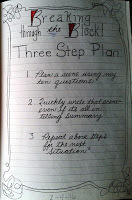 April Theme: BrainstormsBy Marcia Thornton Jones
April Theme: BrainstormsBy Marcia Thornton JonesI’m a big fan of free-association thinking and freewriting. In fact, I have stacks of journals filled with notes, charts, webs, and freewrites. I’m always surprised and delighted at the ideas and insights that are revealed from just putting pencil to paper (or fingers to keyboard).
That being said, I also am aware that I can spend time and energy journaling without ever really making any progress on a specific work. Again, I have all those stacks of journals filled with notes, charts, webs, and freewrites that go absolutely nowhere. That’s why I developed a list of 10 questions to help focus my idea-generating sessions when working on new scenes for a book.
Why not give them a try, and let me know if they help you, too? Marcia’s 10 Questions for Scene Development Use these 10 questions to plan, write, and/or revise your novel scene-by-scene!
Where is the character (setting that anchors the character in a specific place and time)?Why is the character there?What does the character want (goal)?Why does the character believe he/she needs to achieve that goal (internal and/or external motivation based on a perceived ‘death stake’ of physical, professional, or psychological)?What stands in the character’s way (internal and/or external obstacles(s)?What does the character do about it (action)?What happens to keep the character from succeeding (disaster)?What dilemma results from the disaster that requires a decision for the character?What new situation arises from the decision of the character?How is this situation even worse than the situation at the beginning of the scene? Marcia Thornton Jones/2016Linked in: Marcia (Thornton) JonesEmail: marciajones@att.netWeb Site: www.MarciaTJones.comFacebook: Marcia Thornton JonesMentoring: www.carnegiecenterlex.org
Published on April 09, 2016 21:46
April 8, 2016
Storming the Brain --- by Jane Kelley
As I sat down to write this blog, I thought now would be a great time for a new idea. A brainstorm about brainstorms?
But I didn't have any.
I tried my "tricks."
I looked the word up in the dictionary. (Did you know one meaning of brainstorm is harebrained?)
I googled the word. (Gee, lots of companies have brainstorm in their name.)
I did an image search. (Wow, neurons are gorgeous.)
I tried my "treats."
I drank coffee. I ate cookies. I drank more coffee.
Nothing helped.
I wondered, should I go for a walk? Look at some pictures of dendrites? Have another cookie?
I had had an idea yesterday. Something about lightning? It was brilliant---until I started to write it down. Then it seemed harebrained.
How could I be so critical of how rabbits think? At least a rabbit knows how to find food, shelter, and a mate. I didn't know anything. And yet....if I know nothing, then I must have questions.
Yes. Questions! What if a rabbit's mother was killed by a fox? What if the rabbit was frightened of everything? What if the rabbit refused to go with his friends to find food? What if he dug a very deep hole? What if the hole led to another hole with little kits? What if the rabbit thought they were baby rabbits? What if the rabbit discovered that the kits were actually the babies of the fox who killed the rabbit's mother? What would the rabbit do? Smother the babies? Run from the fox again? Or keep his friends?
Ahhhh! I found a storm in my brain.

But I didn't have any.
I tried my "tricks."
I looked the word up in the dictionary. (Did you know one meaning of brainstorm is harebrained?)
I googled the word. (Gee, lots of companies have brainstorm in their name.)
I did an image search. (Wow, neurons are gorgeous.)
I tried my "treats."
I drank coffee. I ate cookies. I drank more coffee.
Nothing helped.
I wondered, should I go for a walk? Look at some pictures of dendrites? Have another cookie?
I had had an idea yesterday. Something about lightning? It was brilliant---until I started to write it down. Then it seemed harebrained.
How could I be so critical of how rabbits think? At least a rabbit knows how to find food, shelter, and a mate. I didn't know anything. And yet....if I know nothing, then I must have questions.
Yes. Questions! What if a rabbit's mother was killed by a fox? What if the rabbit was frightened of everything? What if the rabbit refused to go with his friends to find food? What if he dug a very deep hole? What if the hole led to another hole with little kits? What if the rabbit thought they were baby rabbits? What if the rabbit discovered that the kits were actually the babies of the fox who killed the rabbit's mother? What would the rabbit do? Smother the babies? Run from the fox again? Or keep his friends?
Ahhhh! I found a storm in my brain.

Published on April 08, 2016 03:00
April 5, 2016
Dandelions in the Wind by Deborah Lytton - April Theme
I do my best brainstorming without actually brainstorming. I think of my ideas more like dandelions in the wind, drifting gently through my mind. Sometimes they settle down to take root and other times they pass right by. I am inspired by films, by fairy tales, by photographs, by art and by music. I also find inspiration in memories. Remembering myself as a middle grade and teenage girl. But mostly, I take inspiration from my children. As they have grown, I have made mental notes of the things that matter to them, the dynamics of their friendships and the phrases they invent to give just the right emotional content to words that meant nothing before they were strung together in just that way. I think the best fiction is grounded in real life, in the personalities that seem dynamic enough to be real, the conflicts that remind us of our own journeys, and dialogue that rings true.
I am a big fan of scribbling in notebooks. I have lots of them with nothing but ideas. Some may turn into books some day. And some may be only exercises for my imagination. I find that the best way to play with my ideas is to write them down with a pencil and paper. So many writers are particular about their methods and their writing tools. Some only use fountain pens, and others are all about keyboards. I admit I usually grab whatever notebook has a few empty scraps of paper left and any pen or pencil I can find in my desk or my purse. But this month, I decided to try something new. Instead of rummaging in my purse or the kitchen drawer when inspiration strikes, I have prepared myself. Here's my writing kit, just waiting for some floating dandelions. What about you? What are your secret tools for writing your best ideas?
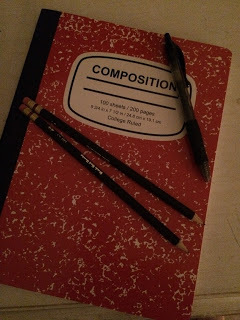
I am a big fan of scribbling in notebooks. I have lots of them with nothing but ideas. Some may turn into books some day. And some may be only exercises for my imagination. I find that the best way to play with my ideas is to write them down with a pencil and paper. So many writers are particular about their methods and their writing tools. Some only use fountain pens, and others are all about keyboards. I admit I usually grab whatever notebook has a few empty scraps of paper left and any pen or pencil I can find in my desk or my purse. But this month, I decided to try something new. Instead of rummaging in my purse or the kitchen drawer when inspiration strikes, I have prepared myself. Here's my writing kit, just waiting for some floating dandelions. What about you? What are your secret tools for writing your best ideas?

Published on April 05, 2016 20:54
April 3, 2016
Welcome to the Magic, Messy Middle
I'm traveling, but I did want to pop in with a quote from my airplane reading: RISING STRONG by Brene Brown:
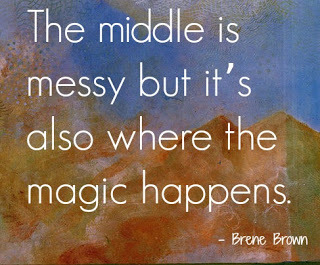
"The middle is messy but it’s also where the magic happens." - Brene Brown
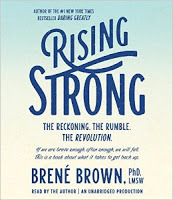 I don't know what this has to do with brainstorming, except that brainstorming, too, is messy and magic. All it asks is that we be open to the what the world is offering us, and brave enough to set it on the page.
I don't know what this has to do with brainstorming, except that brainstorming, too, is messy and magic. All it asks is that we be open to the what the world is offering us, and brave enough to set it on the page.
Messy. Magic. Those are ingredients I want in everything I write. To be messy and magic means to be vulnerable -- not perfect and polished -- RAW. I even want my final drafts to retain some of that raw-ness, that ME-ness... and it all begins with brainstorming, doesn't it?
Wishing each of you magic and messy-ness today and all days!

"The middle is messy but it’s also where the magic happens." - Brene Brown
 I don't know what this has to do with brainstorming, except that brainstorming, too, is messy and magic. All it asks is that we be open to the what the world is offering us, and brave enough to set it on the page.
I don't know what this has to do with brainstorming, except that brainstorming, too, is messy and magic. All it asks is that we be open to the what the world is offering us, and brave enough to set it on the page.Messy. Magic. Those are ingredients I want in everything I write. To be messy and magic means to be vulnerable -- not perfect and polished -- RAW. I even want my final drafts to retain some of that raw-ness, that ME-ness... and it all begins with brainstorming, doesn't it?
Wishing each of you magic and messy-ness today and all days!
Published on April 03, 2016 06:00
April 2, 2016
Idea Mining By Ann Haywood Leal
 “Oh, it is interesting, the creative process. Where was this story before I wrote it down? I don’t know. It certainly wasn’t in my head.” --Gore Vidal
“Oh, it is interesting, the creative process. Where was this story before I wrote it down? I don’t know. It certainly wasn’t in my head.” --Gore VidalI think the idea process is the part of writing that I love most. I like to go to a worn, well-traveled area and sit still with my notebook. Train stations can be perfect for this kind of brainstorming and idea-mining, because of the combinations and variety of people. There will be those who are actually going somewhere, and those who are biding their time, wishing for a destination.
Then I listen -- I mean really listen – to voice inflections and accents, to tones and volume. What is that woman in the corner worried about? What is that young man on the steps so excited about? What is making that couple on the bench so angry? And that woman with the cell phone imbedded in her cheek . . . what is the person on the other end saying?
I’ll try to notice quirks and facial expressions, body language and eye rolling. Then I’ll ask myself, How can I use this?
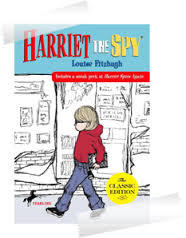 How do I know if that person or that line is worthy of a story? It hangs around in my head for a good while….it’s that phrase I can’t stop thinking about. It makes me wonder, or smile, or cringe, and I have to write it down. One thing that is important for me is to keep myself open to new ideas –not just at the brewing, beginning stages of a story or book, but throughout my writing. This is what starts to round out my characters as I go, and what fills up my story, as a whole. Even after I have that initial motivating idea, I try to keep the brainstorming going.
How do I know if that person or that line is worthy of a story? It hangs around in my head for a good while….it’s that phrase I can’t stop thinking about. It makes me wonder, or smile, or cringe, and I have to write it down. One thing that is important for me is to keep myself open to new ideas –not just at the brewing, beginning stages of a story or book, but throughout my writing. This is what starts to round out my characters as I go, and what fills up my story, as a whole. Even after I have that initial motivating idea, I try to keep the brainstorming going. We take notes on what we see and hear and audition them on the page. Trying out new ideas takes risk and guts, because you can’t leave them floating around in your head. You have to be willing to take it one step further and put them down on the page.
Published on April 02, 2016 18:50



